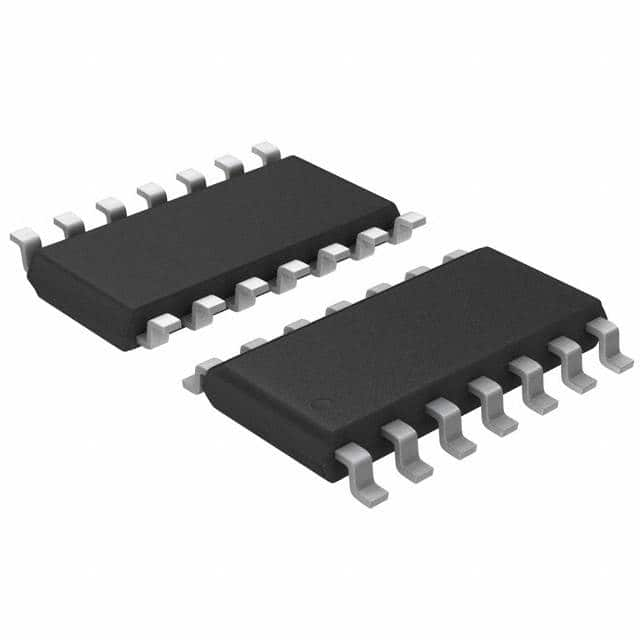Lihat spesifikasi untuk detail produk.

ADM3491AR-1
Product Overview
Category
ADM3491AR-1 belongs to the category of integrated circuits (ICs).
Use
This IC is commonly used for communication and data transmission purposes.
Characteristics
- High-speed data transmission
- Low power consumption
- Small form factor
- Robust design for reliable performance
Package
ADM3491AR-1 is available in a small outline integrated circuit (SOIC) package.
Essence
The essence of ADM3491AR-1 lies in its ability to facilitate efficient and reliable data transmission in various communication systems.
Packaging/Quantity
ADM3491AR-1 is typically packaged in reels or tubes, with quantities varying based on customer requirements.
Specifications
- Supply Voltage: 3.0V to 5.5V
- Data Rate: Up to 20 Mbps
- Number of Channels: 1
- Operating Temperature Range: -40°C to +85°C
- Package Type: SOIC-8
Detailed Pin Configuration
ADM3491AR-1 features an 8-pin configuration:
- DE (Driver Enable)
- A (Data Input/Output)
- B (Data Input/Output)
- GND (Ground)
- VCC (Power Supply)
- Y (Data Output)
- Z (Data Output)
- RE (Receiver Enable)
Functional Features
- Driver and receiver functions for bidirectional data communication
- Built-in protection against electrostatic discharge (ESD)
- Receiver input hysteresis for noise immunity
- Low power shutdown mode for power-saving applications
Advantages and Disadvantages
Advantages
- High-speed data transmission capability
- Low power consumption
- Compact size for space-constrained applications
- Robust design for reliable operation
- ESD protection enhances durability
Disadvantages
- Limited number of channels (1)
- Requires external components for complete system integration
Working Principles
ADM3491AR-1 operates based on the principles of differential signaling. It uses a driver to convert digital signals into balanced voltage levels, which are then transmitted over a communication medium. The receiver at the other end decodes the received signals and converts them back into digital form.
Detailed Application Field Plans
ADM3491AR-1 finds applications in various fields, including: - Industrial automation - Telecommunications - Automotive electronics - Medical devices - Consumer electronics
Detailed and Complete Alternative Models
Some alternative models that can be considered as alternatives to ADM3491AR-1 include: - MAX3485 - SN65HVD11 - LTC2850 - SP3485
These models offer similar functionality and can be used as replacements depending on specific requirements.
Word count: 346 words
Sebutkan 10 pertanyaan dan jawaban umum terkait penerapan ADM3491AR-1 dalam solusi teknis
Sure! Here are 10 common questions and answers related to the application of ADM3491AR-1 in technical solutions:
Q1: What is ADM3491AR-1? A1: ADM3491AR-1 is a specific model of RS-485/RS-422 transceiver IC (integrated circuit) manufactured by Analog Devices.
Q2: What is the purpose of ADM3491AR-1? A2: The purpose of ADM3491AR-1 is to provide reliable communication over long distances using the RS-485/RS-422 standard, which is commonly used in industrial automation, building automation, and other technical applications.
Q3: What are the key features of ADM3491AR-1? A3: Some key features of ADM3491AR-1 include low power consumption, high data rates, robust ESD protection, and half-duplex or full-duplex operation modes.
Q4: How does ADM3491AR-1 ensure reliable communication over long distances? A4: ADM3491AR-1 incorporates features like slew rate control, receiver fail-safe biasing, and enhanced ESD protection to minimize signal distortion and improve noise immunity, ensuring reliable communication over long distances.
Q5: Can ADM3491AR-1 be used in both RS-485 and RS-422 applications? A5: Yes, ADM3491AR-1 can be used in both RS-485 and RS-422 applications. It supports both standards and can be configured accordingly.
Q6: What is the operating voltage range of ADM3491AR-1? A6: ADM3491AR-1 operates within a voltage range of 3.0V to 5.5V, making it compatible with a wide range of systems.
Q7: Does ADM3491AR-1 support hot-swapping of devices? A7: Yes, ADM3491AR-1 supports hot-swapping, which means that devices can be connected or disconnected from the bus without causing any disruption to the communication.
Q8: Can ADM3491AR-1 be used in multi-drop configurations? A8: Yes, ADM3491AR-1 can be used in multi-drop configurations where multiple transceivers are connected to a single bus, allowing communication with multiple devices.
Q9: Is ADM3491AR-1 compatible with different transmission speeds? A9: Yes, ADM3491AR-1 is compatible with various transmission speeds ranging from a few kilobits per second (kbps) to several megabits per second (Mbps).
Q10: Are there any application notes or reference designs available for ADM3491AR-1? A10: Yes, Analog Devices provides application notes and reference designs for ADM3491AR-1, which can help users understand its implementation in different technical solutions and optimize its performance.
Please note that these answers are general and may vary depending on the specific requirements and use cases. It's always recommended to refer to the datasheet and documentation provided by the manufacturer for accurate information.

